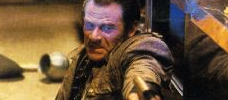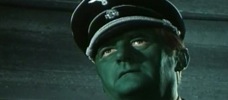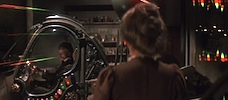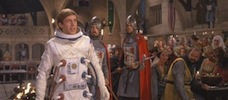Reviews
Steve Miner
USA, 1989
Credits
Review by David Carter
Posted on 10 August 2010
Source Lions Gate DVD
Categories Favorites: Time Travel
Horror cinema became a huge moneymaker for movie studios during the 1980s, but by the decade’s end, the genre was, to put it simply, running out of steam. Repetition was the rule of the day and a quick look at horror titles from 1989 reveals a litany of sequels that represent the nadir of their respective franchises: A Nightmare on Elm Street 5: the Dream Child, Friday the 13th VIII: Jason Takes Manhattan, The Texas Chainsaw Massacre 3, and Halloween 5. Other, less successful films such as C.H.U.D. and The Stepfather were also given the sequel treatment and the handful of “original” horror films released that year (Craven’s Shocker, The Chilling) were most often rehashes of successful formulas in a new context. The homogeneity in horror cinema in 1989 created a situation in which any film that showed a spark of originality would be roundly praised by genre fans and remembered fondly.
Such is the case with Steve Miner’s Warlock, a film that was by no means groundbreaking but one that did put enough of a fresh spin on genre conventions to stand out among its peers. Warlock is the story of the eponymous villain’s struggle against Giles Redferne, a witch-hunter who holds the sorcerer responsible for the death of his beloved. The film begins in 1691 Boston, where Redferne has finally captured the Warlock and imprisoned him in the town jail. Satan opens a portal within the prison to transport the Warlock to freedom, but Redferne leaps through the magical door to once again hunt his nemesis.
Rather than landing a short distance away as they assume, the Warlock and Redferne have actually hurtled through time itself, arriving in 1989 Los Angeles. There, Satan tasks the Warlock with reuniting the pieces of The Grand Grimoire, a spell book containing the name of God, which would grant the holder power to destroy the universe. Redferne begins his hunt anew, finding an unlikely ally in the form of party-girl Kassandra, who has reluctantly agreed to help because the Warlock has cursed her to age prematurely. The Warlock stays one step ahead of the pair, however, his power growing as he finds each section of the book, leading to a final confrontation back in present-day Boston.
For anyone even moderately familiar with horror cinema, Warlock is predictable to a fault, making its time-travel plot device perhaps the only thing that distinguishes it from similar films. One finds it difficult to imagine the Warlock/Redferne conflict being entertaining without the time-shift; setting the film entirely in the past or the present would create only another unnecessary repetition of a thinly drawn good-versus-evil tale. Warlock is one of the few films to feature a time-travel device that’s purely supernatural, thus mitigating the need for any significant part of the narrative to be dedicated to explaining the hows and whys of the time shift.1 Indeed, the characters seem to have no problems accepting this as fact—even Kassandra does not require much convincing to believe that Redferne is from several centuries in the past and not simply an insane person.
The degree to which the event of the Warlock and Redferne’s arrival in the future is downplayed brings up a few narratively troubling questions, most importantly why, if Satan has the ability to send the Warlock centuries into the future, he wouldn’t intervene on his behalf to stop the two people attempting to kill him. Furthermore, Redferne inexplicably returns to his own time at the film’s conclusion, calling into question the entire premise of time-travel in the film. Did Satan send him back? Was it God? Either answer raises even more confusing questions in a film that is already short on answers. These are only two of the many elements of the film that seem to be dictated by convenience rather than logic, and similarly the Warlock’s abilities seem to wax and wane as narratively necessary at the moment. While this is certainly a flaw in the film, it is one that is by no means unique to Warlock as such contrivances were all but expected in horror films of the period. If anything, Warlock does itself a disservice by raising more intriguing questions than one typically expects in such a film.
With the supernatural mechanics of time travel all but assumed, Warlock dedicates the majority of its running time to Redferne and Kassandra, and therefore a good deal of time is spent on “fish out of water” scenarios as Redferne adapts to the modern day. For his part, The Warlock seems to have no trouble acclimating himself to the new time; in fact, he seems tacitly relieved that 1989 Los Angeles is not filled with religious zealotry like 1691 Boston. Two of his first interactions in his new time period are with people who adopt the trappings of witchcraft and in both cases, the Warlock shows them the brutal realities of things they find to be innocuous. On the other hand, most of Redferne and Kassandra’s portion of the film is filled with failed attempts at comedy, such as Redferne’s fear of airplanes and Kassandra’s dismay over aging.
In its episodic structure, Warlock sticks to the most common trope of the horror genre circa 1989. Scenes feel disjointed and formulaic, particularly when the Warlock is involved; most of his scenes begin abruptly and without any set-up with the Warlock and a previously unseen character. We know from the onset what will happen: the Warlock will kill that character in an ironic way but not before tossing off a clever one-liner. It should come as no shock that the villain is the true hero of Warlock, as was the case in almost all of the horror films listed above. The Warlock is a more attractive character on both an intellectual and physical level—he is more refined and erudite, and actor Julian Sands is more “movie star handsome” than his foil, Richard E. Grant. For most of the film, the audience is conditioned to root for the Warlock and his defeat at the end feels more like a necessity than a desired outcome.
One aspect of the film that is not formulaic or predictable is its treatment of homosexual issues. The Warlock’s first victim in Los Angeles is Kassandra’s homosexual roommate, whom he kills by kissing passionately and biting off his tongue. A kiss between two men was unheard of in mainstream eighties cinema and even more so in the notoriously homophobic confines of horror. The depiction of a homosexual man in a non-derisive light was a rarity for horror of the period, and this one is notable despite its brevity. Furthermore, Warlock goes on to spotlight misconceptions about homosexuality by emphasizing the investigating officers’ refusal to focus on anything other than the man’s sexuality while investigating his death. This sensitivity to homosexual issues is made all the more surprising in light of the sexist portrayal of Kassandra as obsessed only with her appearance in the face of the apocalypse.
But despite this one variation, Warlock remains a fairly conventional late-80s horror film. Warlock’s time-travel plot gave it an edge over the glut of horror films released around the same time, but it is ultimately something that is better in theory than execution. Two sequels followed, both of which abandoned the time-travel scenario for a greater focus on gore and one-liners. The dullness of those two films is perhaps the best proof of the benefit Warlock received from the inclusion of time travel as a narrative device, even if it only addresses it briefly. Without it, Warlock is simply another wisecracking killer film, a commodity of which there was far too much of in 1989.
- The other notable film from this time period to feature supernatural time-travel being 1992’s Beastmaster 2: Through the Portal of Time. The influence of Warlock on that film cannot be ignored, however, and these similarities are magnified further when you consider that Warlock’s female lead, Lori Singer, is the sister of the titular Beastmaster, Marc Singer. ↩
More Favorites: Time Travel
-

Bill and Ted’s Excellent Adventure
1989 -

Trancers
1985 -

The Time Machine
1960 -

Groundhog Day
1993 -

Warlock
1989 -

The Navigator
1988 -

Tomorrow I’ll Wake Up and Scald Myself with Tea
1977 -

The Spirit of ‘76
1990 -

Flight of the Navigator
1986 -

La jetée
1962 -

Twelve Monkeys
1995 -

Beastmaster 2: Through the Portal of Time
1991 -

Peggy Sue Got Married
1986 -

Time After Time
1979 -

Somewhere in Time
1980 -

Back to the Future
1985 -

Back to the Future Part II
1989 -

Back to the Future Part III
1990 -

Idaho Transfer
1973 -

Unidentified Flying Oddball
1979 -

Slaughterhouse-Five
1972 -

The Lake House
2006 -

Time Bandits
1981 -

Doctor Who
1963–present -

Doctor Who
1963–present
We don’t do comments anymore, but you may contact us here or find us on Twitter or Facebook.



